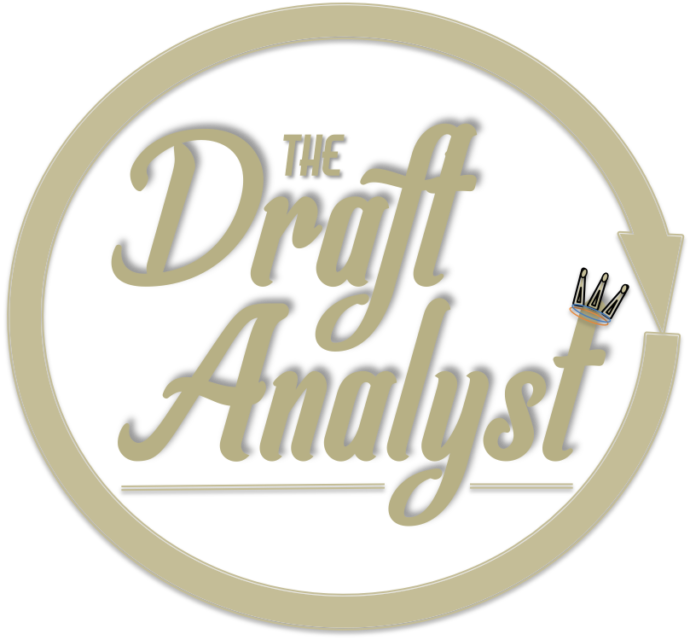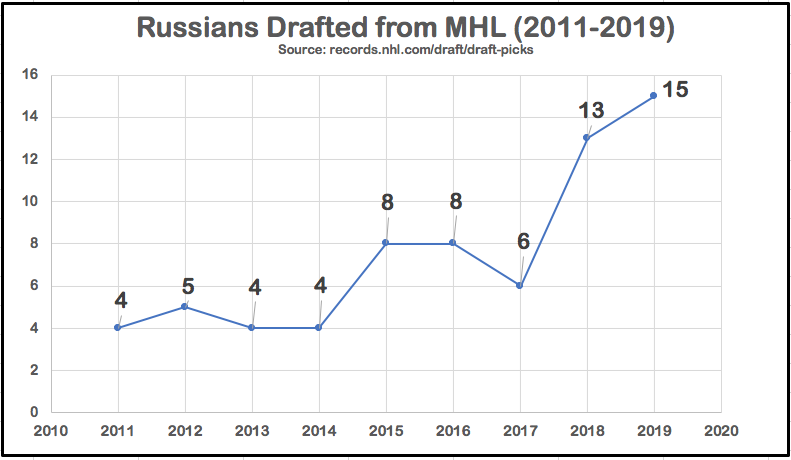2020 Draft: Top-30 MHL Prospects (Russia)
Ross Martin | 5/13/2020 | Nashville | [hupso]
NASHVILLE (The Draft Analyst) — Below is Ross Martin’s ranking of the top first-year eligible prospects in Russia’s under-21 MHL for the 2020 NHL Draft. Each report is based on hours of multiple video sessions and highlights the players most noticeable strengths. Although several NHL teams have been averse to drafting Russian junior league players, the number of those willing to overlook the “Russian Factor” — i.e. the lure of playing professional hockey in Russia’s KHL rather than in North America — has increased (see graphs below).
This report was combined in part with our previous look into the Top-10 Russian draft prospects that included imports playing in North America. Ross, however, combed the depths of one of Europe’s top talent pools to reveal his top-30 list of those whom at one point or another participated in Russia’s premier junior league this season. Simply put, this is the most informative study you’ll find on Russian junior prospects vying for the 2020 draft.
Editor’s Note: We know goalie Yaroslav Askarov (No. 3) didn’t play in the MHL this year. He is such a fantastic prospect, however, that we decided to include him anyway.
1. Rodion Amirov
Right Wing | Tolpar, MHL | 6’0, 167 | 10/2/01 | Shoots Left | 17gp-10g-12a-22pts

The total package when it comes to puck possession and dominating zone time on offense, Amirov is the crown jewel of an excellent Russian draft class. He spent most of the first half with the KHL’s Salavat Ufa squad — a rarity for first-year draft eligibles — and also stood out for Team Russia during the November Super Series versus the Canadian Hockey League’s All-Star team. Amirov’s strong in so many categories related to both sides of the rink, he’d likely be in the running for the top three of the 2020 draft had he been given more attention; especially after the way he torched the MHL in the second half.
Amriov is an elite stickhandler and is incredibly reliable when entering the opposing zone. He cleans up a lot of mistakes for his teammates and quickly transitions into attack mode. Amirov owns an excellent shot-release combination and fires pucks off the pass as accurately as any forward within his peer group. Powerful on his skates and elusive in traffic, he is all but guaranteed to be the first Russian skater taken at the draft.
For a more detailed scouting report and video highlights, click here.
2. Marat Khusnutdinov
Center | SKA-1946, MHL | 5’11, 176 | 7/17/02 | Shoots Left | 44gp-13g-25a-38pts

Khusnutdinov may have a long last name that’s look difficult to pronounce (it’s Koos-new-dee-nov), but the results he produces on the ice are quick, effortless, and practically impossible to forget. He’s played off the top line of a powerful SKA-1946 team but still managed to average nearly a point a game despite rarely seeing the bulk of offensive-zone starts and time on the first power-play unit. Khusnutdinov also represented Russia on the international stage with impressive showings at the under-20 World Junior “A” Challenge, and the under-18 Five Nations and Ivan Hlinka tournaments.
Unlike Amirov’s workmanlike approach, Khusnutdinov is a flashy and excitable player, albeit one who also pays attention to his defensive-zone responsibilities. He can beat you with his speed inside or outside, but also battle hard along the boards before slipping undetected into a soft area near the goal. Khusnutdinov is a natural center who can be an effective playmaker and also win the majority of his draws.
For a more detailed scouting report and video highlights, click here.
3. Yaroslav Askarov
Goalie | SKA-Neva, VHL | 6’3, 176 | 6/16/02 | Catches Right | 12-3-3, 2.45 GAA, .920 Save %
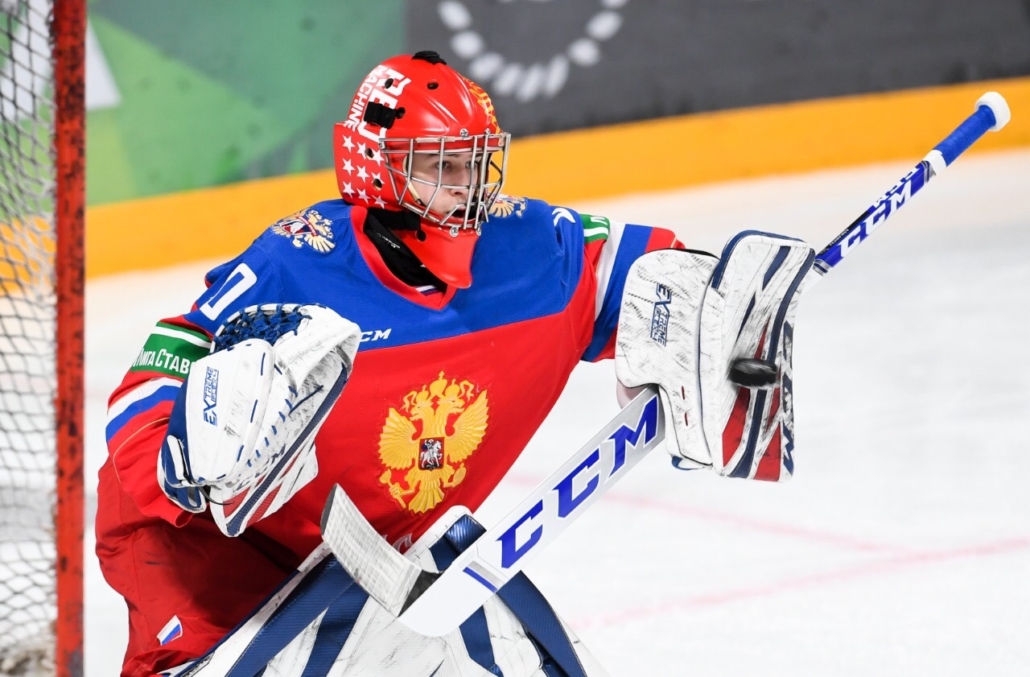
The most heralded goaltending prospect since Carey Price some 15 years ago has had an up-and-down draft year, but the fact still remains — no netminder in this draft has shown the potential for stardom the way Askarov has.
For starters, the 17-year-old backstop was the youngest goalie in VHL history to appear in more than nine games. In fact, Askarov shared duties with 1998-born backstop Alexei Melnichuk. In November, Askarov became the youngest goalie in KHL history to record a win, which he registered after a 23-save effort against Sochi. And all this was after he stonewalled one of the strongest Canadian entries in recent memory in the gold medal game at the under-18 Ivan Hlinka Memorial Cup last August. Last season, Askarov out-dueled American prodigy Spencer Knight several times and led Russia to within a goal of the IIHF under-18 world championship, and that was after he won gold at the World under-17 Hockey Challenge.
As you can see, Askarov’s pre-draft resume is stellar, even if his showing at the last under-20 world junior championship (2-2-0, .876 save percentage) was more disconcerting than it was promising. But again, the fact that Askarov at 17 was entrusted with leading Russia in a tournament they always reserve for 18 or 19-year-olds speaks more about his potential than the actual games themselves. Goalies, moreso than any other prospects, have steeper learning curves, and those rewarded with playing time against adults or older competition should not be punished. Especially if they’ve proven to dominate their own age group.
From a technical standpoint, Askarov’s style draws a lot of attention. Not only does he catch with his right hand, but he remains perfectly upright throughout his shuffling with his stick blade on the ice and his head totally locked into puck movement. To some, this may seem nonchalant or overconfident, but Askarov can snap into a textbook butterfly ready stance in an instant when facing a shooter. He will challenge shooters above the paint, but losing the net is something he’s shown to do from time to time. When he gets beat, however, it usually takes a labeled shot with a clear line of sight. If he can fine-tune his net awareness and be more consistent playing the appropriate depth in relation to shooting angles, then the cliche criticisms that focus on his glove-hand positioning would be rendered moot. Especially when his lower-half coverage, strong and controlled lateral pushes, and acute awareness make high-danger and second-chance opportunities almost impossible.
For Askarov’s complete scouting report, click here.
4. Dmitry Zlodeyev
Center | MHK Dynamo, MHL | 5’11, 185 | 2/15/02 | Shoots Left | 42gp-12g-16a-28pts
Zlodeyev is as complete a two-way center as you’ll find. He’s a quick, upright skater with timely bursts into open ice, but there’s a significant level of violence to the way he moves; almost like a tiger increasing its rate of speed as it locks in on its prey. Zlodeyev is a big hitter and puts opposing defensemen on notice once they collect the puck with him bearing down on them. Not only can he run the power play from the half wall, but also anchor the top penalty-killing unit and win almost 57 percent of his faceoffs.
He’s been a top-six center alongside the likes of wingers Bogdan Trineyev and Ivan Didkovskiy at both the national and club level, and the chemistry they share is obvious from the moment they hit the ice. Both are physical players, but most of the possessions inside the opposing end rely on Zlodeyev’s expert puck control and protection. Additionally, it’s Zlodeyev’s quick stick, high motor, and strong desire to separate opponents from the puck that helps his line keep the ice tilted in their favor.
Zlodeyev can be an absolute shark in the neutral zone and reacts to puck travel extremely well. His anticipation and aggressiveness combine to present significant problems for opposing defenders trying to execute a clean breakout, but Zlodeyev’s physical component adds a whole new paint job on things. He can deliver bone-crunching hits, even if it means vacating a spot on his side of the ice and ending up on the other. Compounding things even more is his quick-strike mentality, and the familiarity he has with Trineyev results in multiple odd-man chances or clean zone entries that result in a quality scoring chance.
Skating is not an area of concern for Zlodeyev, who has agility and a quick first step that helps him gain significant separation in open ice. He plays with his head up; usually in search of a trailer or cutter, and he’ll peel back from pressure and allow the situation to clear up rather than force plays or take a low-percentage shot. Zlodeyev is more of a playmaker than he is as a shooter, and wingers like Trineyev and Ivan Didkovskiy get passes perfectly teed up for them to blast on net.
🚨 Дмитрий Злодеев не разбрасывается такими пасами. 2:1 в матче #RUSFIN на #HlinkaGretzkyCup pic.twitter.com/uDhVFVVmWx
— Хоккей России (@russiahockey) August 9, 2019
5. Shakir Mukhamadullin
Defense | Salavat Ufa, KHL | 6’4, 178 | 1/10/02 | Shoots Left | 27gp-0g-1a-1pt
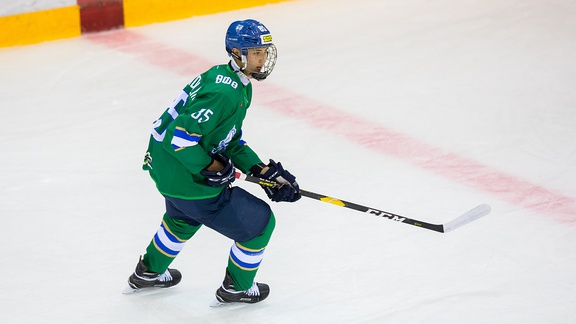
A physical presence on Russia’s blueline at multiple under-20 events, Mukhamadullin is a crease clearer and one-on-one eraser who held his own against premier competition with Ufa of the KHL. You can make a strong argument that he’s the most polished of any draft-eligible defenseman from a quality of competition standpoint, and boosting this value is his multi-situational versatility. How so? When he played against those in his age group in the tight-checking MHL, Mukhamadullin recorded 13 points in 18 games for a 0.72 points-per-game average — the second-highest rate for defensemen in league history. Mukhamadullin also plays as a top penalty killer, shutdown defender, and can quarterback a power play. He also plays over 20 minutes a game and owns one of the hardest shots in the draft while hitting the net with consistency.
Mukhamadullin is a big, rangy defender who oozes top-pairing potential. Not only for his size and booming shot, but also for his poise under pressure and a quick-strike mentality when opposing teams try to establish superiority in a dump-and-chase environment. Mukhamadullin is very crafty during retrievals and his stretch-pass proclivity puts aggressive forecheckers on notice. Although his home-run passes can stretch out defenses, his impressive skating ability under pressure centered on delays, sharp cut-backs, and gear shifting to outpace quick forecheckers. On multiple occasions with Team Russia, Mukhamadullin was counted on to play a centralized role on the power play, and the leading playmaking forwards such as Marat Khusnutdinov and Vasily Ponomaryov consistently looked to set him up for one-timers.
On the defensive side, Mukhamdullin is a physical crease clearer who uses his stick to send a message. He’s played against quicker, older teams in the past, so don’t bet on him being intimidated by the best of his draft-age peers. If anything, they have to prepare for him, especially if they want to mitigate Mukhamadullin’s strong blue line presence and textbook stick-on-puck techniques. He is very quick to the puck and makes timely step-ups and reads, and when the situation presents itself, Mukhamadullin will take the puck for a skate and drive the net with confidence. Like most young defensemen in a lead role, Mukhamadullin can be guilty of trying to tackle every problem on his own, albeit with good intentions. There’s nothing too “raw” about him but a few adjustments is all he needs to become on the top defensemen Russia has produced in several draft classes
Here’s your golden goal … Shakhir Mukhamadullin with an absolute rocket off a #CANEast🇨🇦 body in the high slot to win it for 🇷🇺. #WJAC 🥇 pic.twitter.com/aOcNBcdBGx
— World Junior A Challenge (@HC_WJAC) December 16, 2019
6. Pavel Tyutnev
Wing/Center | Loko Yaroslavl, MHL | 5’10, 185 | 7/25/02 | Shoots Left | 36gp-13g-9a-22pts
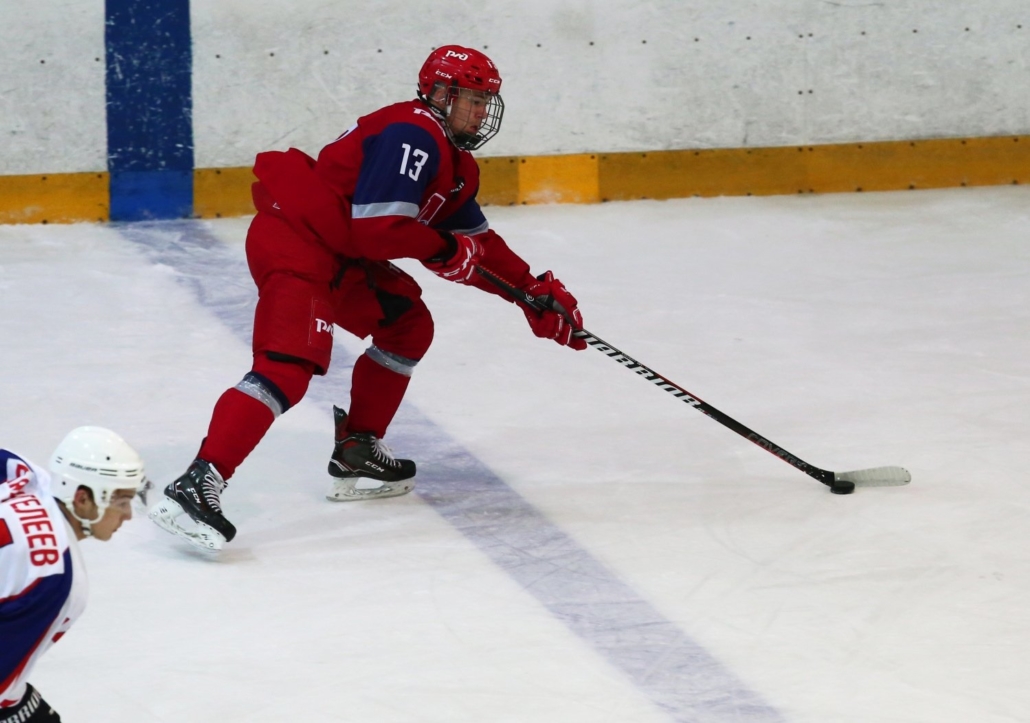
A sturdy, versatile forward with two-way and playmaking capabilities, Tyutnev is one of many under-18 notables who has competed for Russia at all of their key tournaments the last two years who also belongs to a premier organization with playing time at a premium. He was a top-line winger for Russia at both of their gold-medal winning events in 2019-20 — the under-18 Ivan Hlinka in August and the under-20 World Junior “A” Challenge in December — and he played alongside center Vasily Ponomaryov and winger Alexander Pashin at both tournaments. In league play, Tyutnev bounced around from line to line and from role to role on Loko Yaroslavl, playing anywhere from six or seven minutes a game as a bottom-six center to 18 to 20 minutes as a top-line winger. With 13 goals on only 53 shots for a 24.5 shooting percentage, there is no doubt that Tyutnev is earmarked for an expanded role for the entirety of next season.
The highlights of Tyutnev’s game span across all three zones. Like most Russians on both his club and national teams, Tyutnev is extremely well balanced on his skates and is difficult to fix from his desired avenue of approach. He moves laterally with as much quickness and power as he does when moving forward, but he keeps his head up and looks to limit the amount of times he needlessly cedes possession, specifically once he reaches the opposing line. Once he’s inside the zone, Tyutnev is a horse along the boards and a bull behind the net. He’s able to stay under control with more than one defender draped over him, and he reacts and positions himself properly during the cycle. On the power play, Tyutnev is more than proficient at zipping accurate cross-ice or cross-crease passes from the wall, but he also moves near the goal and establishes net-front superiority. His better scoring opportunities generally come via hard work and proper anticipation than simply letting his linemates do the work for him.
One of the most impressive aspects of Tyutnev’s game is his wrist shot. The puck not only explodes off his stick and is usually labeled, but he has soft hands to settle passes of all kinds, and inside a small window of opportunity. Tyutnev handles pucks cleanly on his backhand while moving up ice, and goalies need to concern themselves with a hard, off-wing attempt that is targeted low and to the far post. He can make plays at top speed and using sharp directional changes while altering the angle of his shot attempt.
Tyutnev is an aggressive checker with deceptive speed and quick reaction timing. Once he commits to a target, Tyutnev will not only put his all into the forecheck, but also take the shortest routes available before using his body to separate an opponent from the puck. He was used on the penalty kill with regularity more at the international level than with Lokomotiv, but he should still be considered a trustworthy special teams option for the manner in which he presses the points and keeps his stick active, even at the end of a long kill.
#WJAC: Pavel Tyutnev with an absolute dart, and in a casual 1-on-2 no less. Skorpik should have had this, but sound decision making by a very smart forward. Nothing fancy. Nothing lazy. Nothing safe. Get that goalie moving laterally and exploit that screen.@russiahockey_en pic.twitter.com/xR3dbUlMPo
— Steve Kournianos (@TheDraftAnalyst) December 15, 2019
7. Ivan Didkovskiy
Right Wing | MHK Dynamo, MHL | 5’11, 187 | 1/20/02 | Shoots Left | 37gp-20g-13a-33pts

A quick and physical two-way winger who looks to mash the first opponent he marks in his search radius, Didkovskiy combines a tough-as-nails approach with impressive puck skills to be considered one of the draft’s most pugnacious forwards available. Not only is Didkovskiy a lethal goal scorer blessed with a plus-plus shot, but he also is leaned on for tough defensive-zone situations, penalty killing, and assignments that seem to be designed to throw a top opponent off his game.
Being an in-your-face winger who hits hard and plays with an edge doesn’t limit Didkovskiy’s effectiveness in other areas. He has very quick hands and a soft touch that allows him to stickhandle through traffic and dominate the puck in the possession game. He has been used as a go-to option on the power play, primarily as the shoot-first winger looking to fire off the pass. Didkovskiy’s overall skating is average in terms of speed and first-step quickness but he has a low center of gravity that makes him difficult to knock off the puck. He is also strong on his edges and can angle his body low to the ground as he traverses arounds the net or moves laterally along the line. Didkovskiy averaged over four shots a game while playing close to 17 minutes a match.
Off the puck, Didkovskiy is a relentless forechecker who uses his assertiveness and quickness to deliver massive hits. His efforts while down a man are just as tireless and pressing the points doesn’t only mean being up in a defender’s face — Didkovskiy will shove him hard and even look to deliver a big bodycheck. Sometimes this can get him into trouble by overcommitting, and opponents seem fully aware of his reputation. As the season progressed, however, Didkovskiy appeared to make some adjustments and opt for a more controlled aggression rather than charge in an unbridled, erratic fashion that can leave him in the dust.
RW Ivan Didkovskiy (Ranked No. 114) with a hard-earned PP goal in Dynamo Moscow’s 2-1 loss to Tayfun. He was one of Russia’s top players at a recent under-18 showcase in the Czech Republic, using physicality and quickness…
📸 https://t.co/0nqC46c8XN via https://t.co/r0OWBqxU5A pic.twitter.com/hJLSKDMXIF
— Steve Kournianos (@TheDraftAnalyst) October 30, 2019
8. Aleksandr Nikishin
Left-handed Defenseman | Spartak, MHL | 6’3, 196 | 10/2/01 | Shoots Left | 6gp-0g-3a-3pts

One of the most talked about defenders in the preseason for his penchant for bone-crushing hits, Nikishin spent most of his season in the KHL but bounced back to the MHL for Spartak’s opening-round playoff series. A towering, punishing defenseman, Nikishin is a bit of a throw-back to the days of when defensemen like Scott Stevens put fear into the hearts of opposing forwards. Unlike many of his peers, Nikishin not only has the ability to play the body, but he also seeks out violent contact. To his credit, these hits are both clean and often well-timed, meaning he usually doesn’t go out of position chasing hits for personal glory. Additionally, Nikishin is a solid one-on-one defender, showing impressive gap control for a teenager, an active stick, and the ability to win battles both in front of the net and in the corners.
While creating offense on a shift-to-shift basis is not the primary objective of Nikishin’s game, he is not devoid of offensive ability. He skates well for his size, showing good balance and power in his stride. He also reveals the ability to scoop pucks of the boards on both the forehand and backhand, and he makes intelligent decisions when distributing the puck. Nikishin possesses a powerful shot with little backswing that is often kept low for potential tips or rebounds. He is used on both the power play and penalty kill.
9. Bogdan Trineyev
Left Wing/Right Wing | JHC Dynamo, MHL | 6’3, 198 | 3/4/02 | Shoots Right | 36gp-12g-14a-26pts

Trineyev is a big winger who is still discovering the extent of his talents. Despite the relative rawness of his skills, Trineyev still saw ample playing time both in the MHL and while representing Russia internationally. He has a high offensive IQ, and is consistently in the right place at the right time. His compete level is very high — on both sides of the puck — as he is often seen fighting for the puck along the boards, blocking shots, and taking abuse in front of the net in an attempt to deflect a shot or pounce on a rebound.
Trineyev’s skating ability is decent, but improving. At the moment he can still be caught skating a little too narrow, which robs him of some speed and acceleration. However, when his mechanics are sound, Trineyev flashes impressive speed that catches defenders off-guard. Likewise, Trineyev also shows the ability to surprise defenders on one-on-one or one-on-two situations with a variety of dekes.
For Trineyev’s complete scouting report, click here.
10. Maksim Groshev
Right Wing | Reaktor, MHL | 6’2, 194 | 12/14/01 | Shoots Left | 8gp-3g-2a-5pts
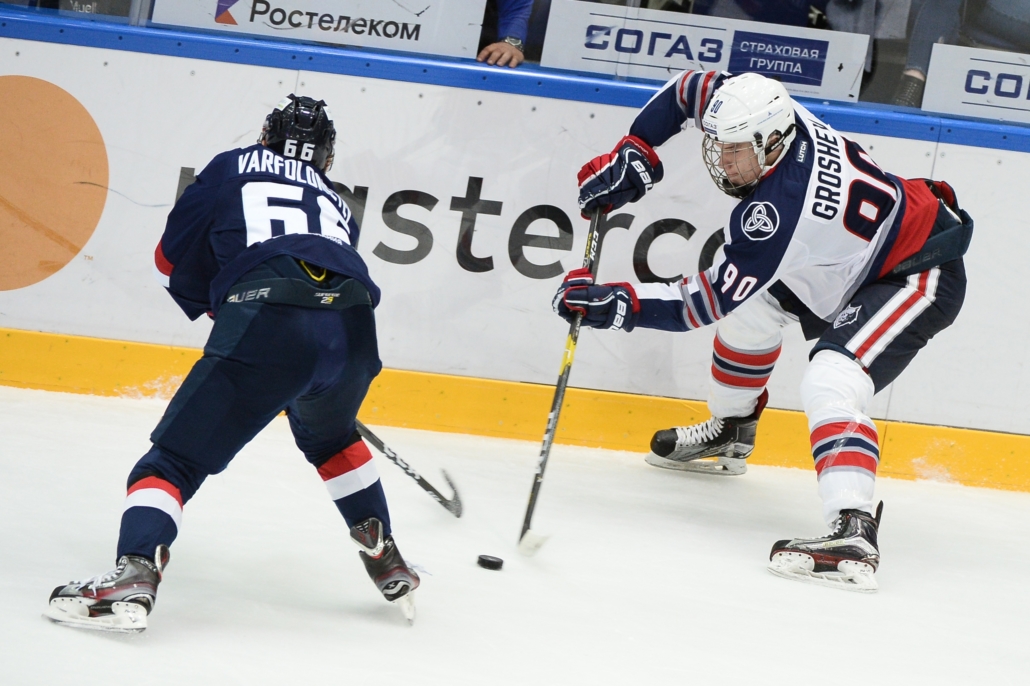
If only one word could be used to describe Groshev’s game, it would be have to “power”. Simply put, Groshev’s game is centered around strength and vigor, both which are predicated on his skating ability. His strides, while not particularly rapid, are explosive. Groshev reaches full speed in short order with long strides and has the balance to maneuver at top speed and withstand contact from opposing defenders. Groshev uses his skating as his preferred method of offense, as he looks more comfortable and has a high success rate at creating opportunities off the rush as opposed to setting up in the offensive zone. Still, Groshev is very capable off the cycle and can wear down opposing defenders with his slick stickhandling, powerful directional changes, and using his big frame to protect the puck as he muscles his way towards the middle.
Groshev is also a diligent player regarding the defensive aspects of the game. He uses his plus speed on the backcheck and does a good job following his charge in the defensive zone. Groshev uses his body and active stick to get into passing and shooting lanes, complicating things for opposing offenses and reducing chances against.
#CHL: Heady play by the kid LW Maxim Groshev (Ranked No. 46) as he races with speed for a shot then whistles a no-hesitation feed that is tipped home beautifully by C Lev Komissarov (2020/2000). Russia’s youngest kids have been consistent all series. pic.twitter.com/H9IwPErASh
— Steve Kournianos (@TheDraftAnalyst) November 15, 2019
11. Aleksandr Pashin
Right Wing | Tolpar, MHL | 5’8, 154 | 7/28/02 | Shoots Left | 37gp-17g-22a-39pts

One of the more offensively gifted players out of Russia this year, Aleksandr Pashin is a diminutive forward with big time talent. He has excellent stickhandling ability while showing the skill needed to make people miss in close. His edges and short-area quickness are sublime, which, when coupled with his hands, often leave defenders looking foolish. Pashin’s offensive IQ is also something to take note of, as he anticipates both player and puck movement with great success, resulting in dangerous opportunities for his team.
As with most small players, there are several limitations and concerns surrounding Pashin regarding his lack of size and ability to win physical battles. However, Pashin does a solid job engaging on the forecheck, especially if he senses an upcoming offensive chance. His defensive game can be described in a similar way — the ability is there but the compete is inconsistent. If that effort can become more dependable, little stands in the way of Pashin becoming a valuable contributor to an NHL roster.
For Pashin’s complete scouting report, click here.
12. Maksim Beryozkin
Left Wing | Loko Yaroslavl, MHL | 6’2, 201 | 10/12/01 | Shoots Left | 51gp-25g-29a-54pts

Establishing himself on Loko Yaroslavl’s top line, Beryozkin plays the style of a modern-day power forward. Beryozkin’s offensive game is dangerous and diverse, as he is equally adept at distributing the puck or wiring a wrister past a goalie. His offensive IQ allows him to use whichever skill he chooses and at the appropriate time; indeed, Loko’s offense appears to run through Beryozkin due to his ability to control the tempo of the game. Additionally, Beryozkin sees regular time on the PP, where he lines up on defense and controls play from along the left wall.
Beryozkin also flashes the ability to be a contributor defensively. He is a regular on the penalty kill, showing an active stick that gets into passing lanes. His offensive ability also makes him a threat that the power play needs to be aware of. Finally, Beryozkin does a good job executing stick lifts while backchecking through the neutral zone.
13. Maksim Krovyakov
Center | SKA-1946, MHL | 6’3, 180 | 5/12/02 | Shoots Right | 61gp-19g-21a-40pts

Logging significant minutes in all situations for one of the better teams in the MHL, Krovyakov has catapulted him into NHL Entry Draft consideration on the basis of his well-rounded and consistent play. Krovyakov’s combination of size and skating ability draw attention whenever he steps on the ice. He shows good acceleration and foot speed for a large young forward, despite skating with a slightly hunched-over stance. Additionally, Krovyakov seems willing to use his size to not only protect the puck, but to intimidate the other team. He plays the body in the corners and along the boards, fights in front of the net to provide screens and hunt for rebounds, and gets involved in extra-curricular activities when they arise.
Krovyakov also boasts an impressive offensive toolset. His wrist shot is strong and accurate, and he can get it off in a hurry. His passing, while not as impressive as his shot, is more than acceptable as well, as Krovyakov shows the ability to consistently feed open teammates. Moving forward, it will be interesting to see if Krovyakov shows more ability to create offense on his own initiative, rather than augmenting and complementing what is created by his teammates. Again, the biggest takeaway from Krovyakov’s season was his use as a 17-year-old center in key situations against heated rivals for a SKA-1946 squad that was loaded up and down their forward ranks. One could say he was their dedicated second-line center but there were multiple instances when he was given the tougher assignments over nominal 1C Alexei Tsyplakov.
Не получилось раз – пробуй два! Именно так считает Максим Кровяков pic.twitter.com/SuJWUGNcHs
— СКА-1946 (@ska1946) October 19, 2019
14. Ignat Kokhanin
Left Wing | Dynamo SPB, MHL | 5’10, 183 | 1/12/02 | Shoots Left | 27gp-1g-5a-6pts
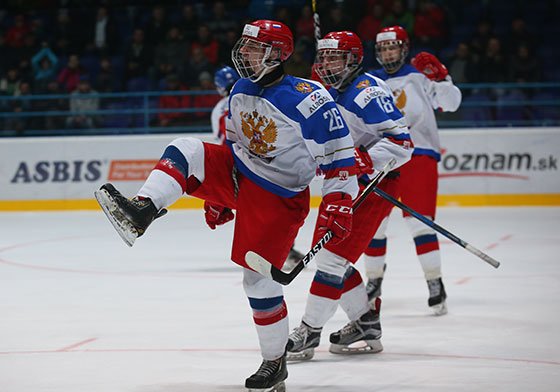
Take my advice — put Kokhanin’s unimpressive statline aside. Despite the lack of league production this year, Kokhanin is a player that should not be overlooked. To start off, this kid can skate. His edges give him excellent functional strength and change of direction ability, while his acceleration and top speed ensures that he gets where he wants to go before anyone else does. Kokhanin uses this speed to great effect, pulling away from opponents in the neutral zone, putting defensemen on their heels at the blue line, and providing back pressure while backchecking.
In addition to great skating ability, Kokhanin also plays a very abrasive style of hockey. He is a beat along the walls and in the corners, using excellent body positioning and sheer effort to come away with pucks. He finishes checks, and even dishes out some nasty open ice shots despite his yet-to-bedeveloped frame. And, while he doesn’t project to be a high-scorer moving forward, he possesses an underrated shot and the ability to get the puck to an open teammate.
Игнат Коханин – золотой гол на Мировом кубке вызова pic.twitter.com/KZO58HeYkU
— Артем Гаев (@gaevart) November 11, 2018
15. Kirill Kondyrev
Center | Russkie Vityaz, MHL | 6’1, 194 | 6/29/02 | Shoots Left | 62gp-16g-13a-29pts
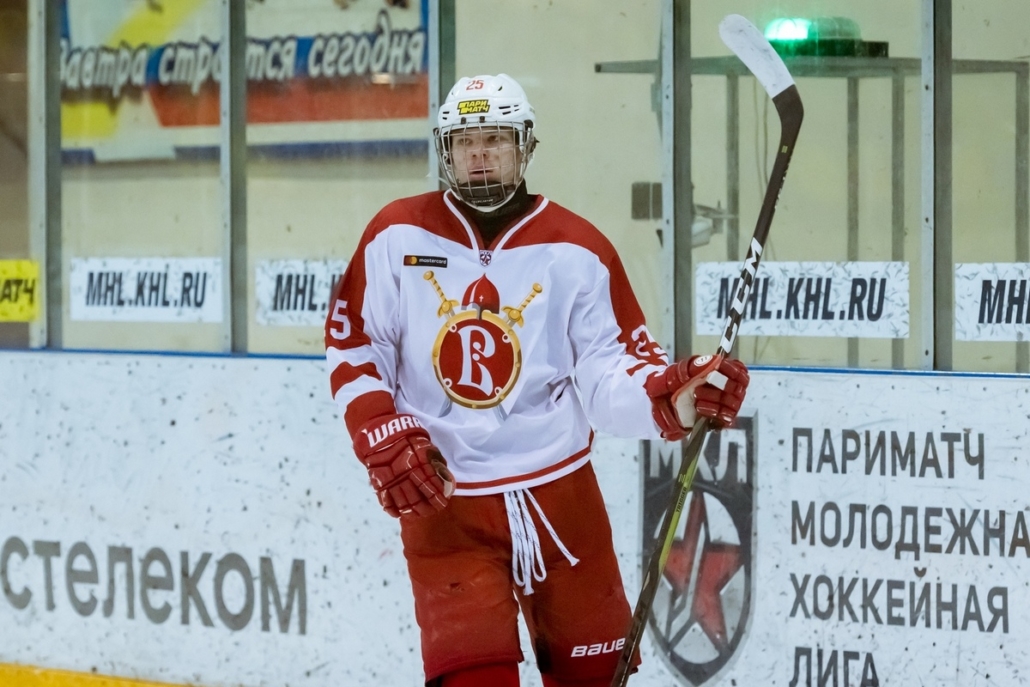
Displaying all the makings of a future power center, Kondyrev burst onto the scene this year with an up-and-coming Russkie Vityazi team. Comfortable creating offense both on the cycle or off the rush, Kondyrev does much of his damage with a strong wrister that can stun a goalkeeper. His speed and power is noticeable; at least once a game, Kondyrev makes a strong move to break into the offensive zone, usually splitting the D when doing so. Physically, while Kondyrev uses his strength to protect the puck and win board battles, there is room for him to be more aggressive in playing the body.
Kondyrev’s defense is a work in progress. While the effort and desire is clearly there, he can be caught stationary at times, and is also guilty of getting pulled out of position. With more coaching and experience, however, this should be correctable. It is also worth noting that his coaches trusted him on both the PP and the PK.
#MHL: Two of my sleeper kids from the MHL were at it again today for Russkie Vityazi in a 6-0 win over Amurskie Tigry.
C Kirill Kondyrev scored a goal, and C Ivan Zinchenko added two more. At this point I’d give Zinchenko the edge to crack the 4th round or higher.
Kondyrev goal pic.twitter.com/biee6P1SWs
— Steve Kournianos (@TheDraftAnalyst) December 16, 2019
16. Ilya Ovchinnikov, C, Avto Yekaterinburg (MHL)
Ilya, whom some may refer to as “the other Ovchinnikov”, is an underrated prospect for the upcoming NHL draft. The hallmark of Ovchinnikov’s game is his skating. While his top gear is probably little more than average for an NHL prospect, his initial burst, balance, and edges are all pluses. Being strong on his blades allows Ovchinnikov to dominate along the boards and in the corners, often winning battles against multiple opponents. It also allows makes it difficult for others to bump him off the puck, allowing him to maintain possession under pressure.
While Ovchinnikov is not a slouch in the offensive zone, he stands out more in the defensive zone. He shows exceptional anticipation ability, which, when coupled with his skating ability, results in multiple clean takeaways and/or blocked shots a game. He supports down low on the breakout, and often acts as the safety valve as his team moves the puck up ice. Offensively, Ovchinnikov profiles more as a facilitator than a shooter, and looks comfortable creating offense from the cycle.
17. Nikolai Smirnov, W, Russkie Vityazi (MHL)
Somebody must have forgotten to tell Smirnov that he is a smaller winger, because, despite his stature, Smirnov is a battler. Indeed, while he does possess the hands and short area quickness that smaller forwards are known for, Smirnov is also a bulldog along the boards and in front of the net, and more often than not is able to leverage his lower center of gravity, skating ability, and strong lower body in order to come out with the puck on his tape. With the puck, Smirnov is more disposed to pass than to shoot, but is still a scoring threat near the blue paint.
Smirnov also breaks the “small offensive winger” mold when it comes to playing defense. While no one will confuse him for a future Selke winner, Smirnov is committed to defense, both in transition and in the zone. Like his line mate Kondyrev, this attention to defense saw Smirnov rewarded with plenty of ice time in all situations, including on the power play and penalty kill.
18. Sergei Safin-Tregubov, D, Tolpar Ufa (MHL)
Every time Safin-Tregubov steps on the ice, something exciting happens. It may be to the benefit of his team or it may cost them, but Safin-Tregubov plays that high-risk/high-reward style of game that ensures that fans will get their money’s worth. Offensively, he is like a 4th forward out there. He is routinely down below the hashmarks, swooping down into the slot, or even behind the opposing team’s net. Despite this aggression, Safin-Tregubov displays impressive offensive IQ, as these forays often result in quality chances for his team, and rarely backfire. This mentality is combined with impressive offensive skills- most notably, impressive hands that beat defenders one-on-one.
Safin-Tregubov is no less of a riverboat gambler on the defensive side of the puck. Because of this, he can get caught out of position. On the other hand, because of this willingness to gamble, he often makes plays others can’t. He’ll execute poke checks, throw hits, and compete along the boards and in front of the net. Both his offensive and defensive game is heavily influenced by his skating- while Safin-Tregubov’s speed and acceleration is no more than average, his edges and balance allow him to keep up and/or beat the opposition.
19. Dmitri Ovchinnikov, C/W, Siberskie Snaiperi (MHL)
Ovchinnikov is a versatile forward that shows the ability to affect every aspect of a hockey game. Offensively, Ovchinnikov is a player whose whole is greater than the sum of his parts. His game is well-balanced, and he does a lot of little things that other players sometimes forget to do, all of which lead to better results for his team. Defensively, Ovchinnikov does a phenomenal job in all three zones, whether it is covering for a pinching defenseman in the offensive zone, hustling on the back check through the neutral zone, or keeping his head on a swivel in the defensive zone.
Every year, certain players seem to get more attention/love from draft enthusiasts than from NHL Central Scouting; Ovchinnikov is such a player. After scorching the MHL at over a point-per-game pace, and getting rewarded with time internationally and in the KHL, many were surprised to see Ovchinnikov left unranked when CSS’s final rankings came out. However, it only takes one team to render such a ranking (or, rather, lack thereof) invalid.
For a detailed report on Ovchinnikov, click here.
20. Sergei Yudin, W, Kuznetskie Medvedi (MHL)
An interesting mix of offensive ability and aggression, Yudin has established himself as a legitimate prospect in this year’s Entry Draft, despite playing for a struggling team in the unbalanced Eastern Conference of the MHL. Offensively, Yudin displays the ability to beat defenders one-on-one in a myriad of ways; among them being a particularly devastating toe-drag. Additionally, he also uses this toe-drag to change the angle of his wrist shot (which Yudin unleashes quickly and with surprising power). He is also a capable passer, though he can-at times- be guilty of trying to beat one man too many.
While offense will likely be Yudin’s calling card moving forward, he shows the willingness and ability to contribute in other aspects of the game. The most glaring of example of this is his enthusiasm for physical play. Indeed, despite being a smaller player, Yudin shows the willingness (perhaps too much, even) to engage physically in all three zones, including impressive reverse-checks that can stun opposing defenders. Additionally, Yudin shows good pursuit through the neutral zone when backchecking, and regularly attempts stick lifts in order to re-gain possession of the puck.
21. Nikita Kiryanov, C/W, Loko (MHL)
Kiryanov is sure to pique the interest of a few teams this year, showing flashes of skill that are rarely found in 6-foot-4 teenagers. In particular, his skating is ahead of where one might expect; Kiryanov shows good knee bend and leg extension, though a lack of strength hinders his acceleration and top speed. His hands are likewise impressive, as Kiryanov has the ability to pull off some slick moves in close quarters. Kiryanov appears committed to playing a complete 200 foot game, showing the willingness to not only battle for pucks along the boards in the offensive zone, but hustle on the backcheck and get in shooting lanes in the defensive zone.
Gaining strength will be paramount to Kiryanov’s game moving forward. Luckily, he has the kind of frame that should allow him to put on mass without getting overly bulky. Kiryanov seems cognizant of his current lack of strength, and thus doesn’t physically assert himself as much as one would like to see. It will be interesting to see if this part of his game will grow as he gets stronger.
22. Ivan Zinchenko, C, Russkie Vityazi (MHL)
Zinchenko is another player who established himself as a legitimate draft prospect this season. A fiery competitor, Zinchenko has no qualms about getting his nose dirty, and can often be seen engaging physically or getting involved in post-whistle activities, although he needs to add weight and strength. Although he kills penalties and is a shorthanded threat, Zinchenko is a passable defensive player whose biggest impact on a shift-to-shift basis comes on offense. He possesses a strong wrist shot and a high offensive IQ that allows him to get to the dangerous parts of the ice.
It may take Zinchenko a little bit to get up to top speed (a flaw which may be correctable with more strength), but once there, he is among the fastest players on the ice. This speed allows him to be a threat off the rush, as well as catch up to opponents on the backcheck. Like his team mates Kondyrev and Smirnov, Zinchenko is a mainstay on both the power play and penalty kill.
Zinchenko Goal 1 (a beauty): pic.twitter.com/zTJoP6JFLI
— Steve Kournianos (@TheDraftAnalyst) December 16, 2019
23. Nikita Shuidin, C/W, SKA-1946 (MHL)
Well-balanced and versatile, Shuidin can find a home on any style of hockey team. He understands the game well, and knows when it is time to push the attack or time to fall back. His recognition of when and how to support his defensemen is particularly laudable. While playing center, Shuidin truly acts like a 3rd defenseman, getting low in the zone and making sure nobody is in the slot unaccounted for. On the wing, he covers the point well and understands his role in breakouts. And while Shuidin’s skating isn’t special, it won’t hold him back moving forward.
As one might expect, Shuidin appears equally comfortable running the offense or playing off the puck, and can fill either the role of facilitator or finisher. His best offensive attribute may be his puck possession game; despite not being overly big or strong, Shuidin has the uncanny ability to maintain control of the puck along the boards or in open ice.
24. Filat Zotov, D, Russie Vityazi (MHL)
With his calm demeanor and smooth play, Zotov had a breakout season this year, earning ample playing time in all situations in the MHL, and also suiting up for the Russian U-18 team in several competitions. Zotov plays a very mature game for such a young defender- he doesn’t get sucked into trying to do too much on offense, and doesn’t fall for fancy dekes very often. Furthermore, Zotov does not get caught chasing hits, as he instead relies on smart positioning and a slick pokecheck to control play. Indeed, Zotov shows an uncanny ability to put stick on puck, thus breaking up passes and deflecting shots away from his net.
While offense is not the focus of his game, Zotov shouldn’t be considered a hinderance to his team here. He looks comfortable with the puck, and can either instigate breakouts with an accurate pass or with his feet. His passing in the offensive zone is clean and safe, and his pinches are smart and timely.
25. Aleksandr Agapov, W, Penza (VHL)
Like many young players who have the benefit of playing in a professional league, Agapov presents a surprisingly mature game, especially when it comes to defense and puck battles. Agapov covers for pinching defensemen, keeps and active stick in shooting and passing lanes, and is generally unafraid of putting himself in harm’s way, whether that is blocking a shot, taking abuse along the boards or battling in front of the net.
Offensively, Agapov is still working to translate his innate abilities to in-game situations. There is a huge jump in competition between playing against one’s age-group peers and playing against grown men- even if it is “just” the VHL. Opponents are stronger, faster, and their skills are more developed. Agapov seemed acutely aware of this, occasionally deferring to his teammates when he showed have taken the offensive initiative. Interestingly, though perhaps unsurprisingly, this occurrences were more prevalent when Agapov was presented with time and space. When forced to rely on his raw talent and instincts with the puck, Agapov showed not only impressive hand-eye coordination and the ability to make defenders miss, but also the ability to protect the puck against bigger and stronger defenders. Expect these talents to be on display more next season as Agapov continues to adjust to mature and adjust to the jump in competition.
26. Daniil Zaitsev, D, Avto Yekaterinburg (MHL)
A late-2001 birthday, Zaitsev may be the straw that stirs the drink offensively for a strong Avto Yekaterinburg team. Zaitsev saw plenty of ice-time in a variety of situations- including playing the role of quarterback on the PP- and was responsible for setting up breakouts when on the ice. Offensively, Zaitsev clearly feels comfortable with the puck; unless forced to, he doesn’t just wrap the puck around the boards. Instead, passes are crisp and on target. His shot shows good power, though it looks like Zaitsev is not confident in his one-timer just yet.
Defensively, Zaitsev shows the ability and inclination to be physical with puck carriers, though a slow first step and subpar edges occasionally cause him to either miss or end up out of position. His instincts are generally good, as it is rare to see him beat one-on-one. Zaitsev also gets involved in postwhistle scrums, and shows the ability to stay in control and thus avoids putting his team down a man.
27. Nikita Borodayenko, C, Spartak (MHL)
Borodayenko is versatile center that seems to do a little bit of everything for a strong Spartak team. A natural pivot, Borodayenko displays a strong understanding of his responsibilities no matter the situation. He shows excellent recognition skills on defense, keeping his head on a swivel to prevent opponents from getting into dangerous areas unchecked. He also displays an impressive ability to anticipate passes, and routinely appears out of nowhere to intercept passes. His defensive ability is showcased not only at even strength, but on the penalty kill as well.
Borodayenko is no less of a thorn in his opponents’ side on offense as well. A diligent forechecker, he prefers a finesse-based style, relying on body positioning and stickwork more than physicality. Once he acquires the puck, Borodayenko can either find an open teammate or fire a nice wrister on net himself. Borodayenko saw limited time on the power play this season.
28. Vladimir Mashkov, W, Omskie Yastreby (MHL)
A slight winger who doesn’t let his lack of strength change his game, Mashkov had an impressive season for Omsk. Despite his lack of size, much of Mashkov’s game is based on going to the dirty areas of the ice and battling. He is active on the forecheck, often getting the puck himself or forcing defenders to rush. Furthermore, Mashkov will jockey for position in front of the net, providing a screen and hunting for rebounds. He also displays a quality wrist shot.
Mashkov’s intensity is matched in the defensive zone. He regularly picks up the backside defenseman attempting to sneak to the far post, and will engage physically in order to keep the slot clear. Mashkov is also an active participant on the breakout, as he rarely leaves the zone early, and usually does a good job presenting himself as an outlet option for his defenseman.
29. Anton Kosolapov, W, Dinamo Moskva (MHL)
Kosolapov is yet another forward that spent the season with Dinamo Moskva in the MHL. While less heralded than some of his teammates, Kosolapov still shows some attributes that make him a player to keep an eye on moving forward. The most eye-catching of these attributes are his shot- which has both power and accuracy- and the ability to receive difficult or firm passes without losing or bobbling the puck. As the season progressed, Kosolapov began to look more comfortable going to the dirtier areas of the offensive zone, particularly when it came to going to the front of the net to provide a screen or to look for rebounds.
Defensively, Kosolapov is responsible, if unextraordinary. He shows a solid understanding of his responsibilities in his own zone, and does an admirable job covering the point, and keeping his body and/or stick in both shooting and passing lanes. In short, while he is no Patrice Bergeron, Kosolapov is the kind of safe player that coaches can trust with a regular shift.
For a detailed report on Kosopalov, click here.
30. Yegor Smirnov, D, Dinamo Moskva (MHL)
Though still quite raw, Smirnov possesses some intriguing potential. Perhaps the first thing that jumps out about Smirnov is his size- and his willingness to use it. Indeed, Smirnov knows what is expected from a big defenseman such as himself, and shows no qualms about using his size along the boards, in front of the net, or even in open ice (he is still learning to time these open-ice hits, however). This aggression is coupled with surprising straight ahead speed, which ensures that opponents must keep their heads up when he is on the ice.
In addition to size and physicality, Smirnov shows some solid IQ and self-awareness. He rarely tries to get fancy with the puck, instead opting for the safe play. Additionally, Smirnov seldom allows an opponent to slip into a dangerous area uncovered His positioning is solid, as he is usually in the right place at the right time. Smirnov even shows an impressive sense of when to join the rush on the attack, and the ability to drive to the net to create passing or shooting lanes for his teammates.
